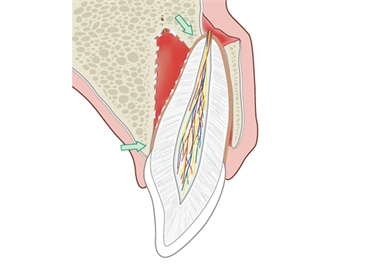Lateral Luxation of tooth - prognosis, management and treatment
July 19, 2023



In late 1550s, luxationem was a Latin word coined to describe a joint or bone that is displaced obliquely or in a slanting direction. In dentistry, lateral luxation is used to describe a type of fracture of the tooth where the tooth is displaced within the socket sideways and might be compressed against the wall of the socket.
Clinical findings in lateral luxation
When a patient suffers from a lateral luxation type of injury, the tooth will be displaced but the level of mobility varies. In cases where the socket wall is fractured, there is less mobility as the roots are locked within the socket wall. In cases of lateral luxation of primary teeth, the patient can present with pain and interference in bite as well.
Gingival bleeding is commonly found in cases of lateral luxation. Moreover, there is significant gap between the tooth and the ligament that binds it to the socket. A vitality test is done to know the health of the blood vessels and nerves of the tooth.
Radiographic findings
A radiographic investigation is necessary to know the extent of fracture. The direction of the fracture can be established by radiographs taken from multiple angles.
Lateral luxation treatment for permanent teeth
In mature permanent teeth, the tooth is first repositioned digitally (manually with fingers). The tooth is then stabilized for 4 weeks with a splint. After two weeks, the tooth’s vitality is assessed and accordingly it is decided whether a root canal treatment is needed or not. If a root canal treatment is opted for, then the placement of an antibiotic medication may be needed in order to reduce the inflammtion and infection.
A similar method is followed for permanent teeth with incomplete root formation. However, the difference lies in the type of root canal treatment. In tooth with incomplete root formation, treatment goals focus on first closure of the root apex before going for root canal treatment. The closure of this root apex may occur by physiologic means, meaning that new blood vessels can form immediately and help in normal closure of the root. If no progress is seen in the closure of root apex, then an apexification procedure is carried out, where a biocompatible material is placed to take the form of a root-end closing material.
Lateral luxation treatment for primary teeth
If there is no major change in the positioning of the tooth, then the luxated primary tooth is allowed to reposition itself. However, parents of children are advised that this treatment option can take 6 months to show the optimum results.
Apart from the treatment involving repositioning, splinting and root canal treatment, primary teeth may also be extracted if the tooth is mobile and there is a visible risk of the child aspirating the mobile tooth. It should be noted that extractions of fractured deciduous teeth must be carried out by pedodontists who are trained to reduce the amount of dental anxiety a child may suffer from following a tooth extraction.
Follow-up
Follow-up occurs at 6 weeks, 8 weeks, 12 weeks, 6 months and 1 year. During these recall visits, the tooth is examined both clinically and radiographically. The position of the tooth in normal occlusion and the health of the tooth supporting structures is assessed.
Prognosis for lateral luxation and its treatment
A favorable prognosiswould be absence of any infection or inflammation of the affected tooth. In cases of immature permanentt teeth, continued root development is the best outcome. The best outcome for pediatric patients would be that the permanent successor is unharmed without any change in the path of eruption.
Since repositioning the tooth digitally is one of the first steps of treatment of lateral luxation, radiographic success is ensured only if, after removing the splint, the height of the surrounding bone is appropriate in relation to the tooth.
The most unfavorable prognosis would be ankylosis of the luxated tooth. In this, the tooth becomes fused with the socket. Another unfavorable outcome would be resorption of the roots. Necrosis of the pulpal tissue can occur if root canal treatment is not done in a timely manner.
Lateral luxation is a painful condition which must be addressed immediately. An expert team of dental surgeons must be cnsultedin order to ensure both esthetic and functional rectification of the affected tooth.

